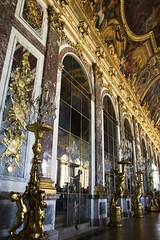The Hall of Mirrors (French: galerie des glaces) is the central gallery of the Palace of Versailles and is one of the most famous rooms in the world.
As the principal and most remarkable feature of King Louis XIV of France’s third building campaign of the Palace of Versailles (1678-1684), construction of the Hall of Mirrors began in 1678 (Kimball, 1940; Nolhac, 1901; 1925; Marie, 1968; 1977; Verlet , 1985). To provide for the Hall of Mirrors as well as the salon de la guerre and the salon de la paix, which connect the grand appartement du roi with the grand appartement de la reine, architect Jules Hardouin-Mansart appropriated three rooms from each apartment as well as the terrace that separated the two apartments (Marie, 1968; 1977l Verlet, 1985a). The principal feature of this famous hall is the seventeen mirror-clad arches that reflect the seventeen arcaded windows that overlook the gardens. Each arch contains twenty-one mirrors with a total complement of 357 used in the decoration of the galerie des glaces (Verlet, 1985a). The arches themselves are fixed between marble pilasters whose capitals depict the symbols of France.[citation needed]
These gilded bronze capitals include the fleur-de-lys and the Gallic cockerel or rooster. Many of the other attributes of the Hall of Mirrors were lost to war for financial purposes, such as the silver table pieces and guéridons were melted by order of Louis XIV in 1689 to finance the War of the League of Augsburg.
In the 17th century, mirrors were among the most expensive items to possess and at the time, the Venetian Republic held the monopoly on the manufacture of mirrors. In order to maintain the integrity of his philosophy of mercantilism, which required that all items used in the decoration of Versailles be made in France, Jean-Baptiste Colbert enticed several workers from Venice to make mirrors at the Gobelins Factory.
The Gobelins, which still exist today, was nationalized in the 1660s by Colbert for the express purpose of making furniture and other decorative items for Versailles and other royal residences.
According to legend, in order to keep its monopoly, the government of the Venetian Republic sent agents to France to poison the workers whom Colbert had brought to France (Verlet, 1985a). The Hall of Mirrors' technological innovation which made it such an exceptional space during its day was the high temperature melting process of glass which was utilized to construct the mirrors. This was the first time this process had been done adding to its significance.[citation needed]
Tuesday, December 09, 2008
Subscribe to:
Post Comments (Atom)


No comments:
Post a Comment